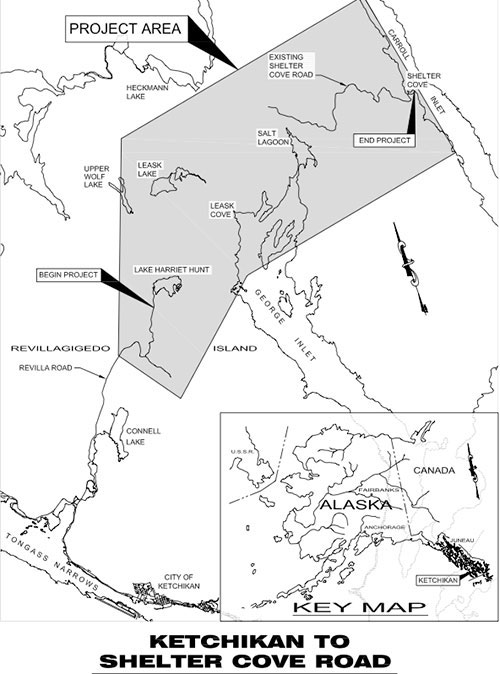
Lawsuit Challenges Road Project From Ketchikan to Shelter CoveBy MARY KAUFFMAN
April 16, 2016
The lawsuit is to force supplemental analysis on the environmental consequences of the Ketchikan-to-Shelter-Cove road project on Revillagigedo Island in southeastern Alaska. The project's bids were due Thursday. The project would provide a public surface transportation link that would extend the existing Ketchikan road system to the Shelter Cove road system. Click here or on the map for a larger image.
Stedman said, "The access created by the road will also benefit potential timber sales and the jobs that come with the sales. Given our huge deficits and downturn in the oil and gas industry, the State needs to focus on other ways to create jobs and economic development so Alaskan families can survive." The lawsuit challenges the Forest Service's recent approval of a right-of-way easement for a one-mile segment of the road that would cross national forest land, and the Army Corps of Engineers' issuance of a wetland fill permit, which allows seven miles of road (including the national forest segment) to be built. The rest of the construction would be on state land. The road construction would connect Ketchikan to about 53 miles of existing logging roads in the Saddle Lakes area. According to the five environmental groups, this region already has a very high road density of nearly two miles of road per square mile; local wildlife populations are already stressed from about 14,000 acres of clearcut logging over the past two decades. "At issue is the connection of Ketchikan to the presently isolated area beyond George Inlet, which has an existing high density of logging roads," said Sitka-based Larry Edwards of Greenpeace. "Making road connections from communities to areas that have a high road density is known to pose a threat to the sustainability of populations of Alexander Archipelago wolves, marten and other sensitive wildlife species due to increased hunting and trapping pressure, including poaching." The 7.3-mile, one-lane gravel road link would be built by the State of Alaska, which put it out for bids March 15. The expected cost is $19 million, and $21 million is budgeted. The construction would extend eastward from the existing White River Road, which now ends at Leask Creek. It would proceed to Salt Lagoon, at the head of George Inlet, and then northward. The north end would connect to an existing logging road that goes eastward to Shelter Cove, on Carroll Inlet. "The federal agencies did not follow federal law to consider hunting and trapping pressure, wildlife disturbance and user conflicts that the road connection will cause," said Gabe Scott of Cascadia Wildlands. "It is important that the agencies go back to the drawing board to ensure that wildlife, hunters and recreational users are fully considered." The suit has no effect on road access from Ketchikan to upper George Inlet or on the potential for a boat launch ramp and dock somewhere along the inlet's shore between the White River and Leask Creek. "Plowing forward with this road connection before determining the consequences of doing so has the process entirely backward," said Dune Lankard, the Center for Biological Diversity's representative in Alaska. "This project is part of the logging industry's grand scheme to access old-growth forests that we're determined to protect." Funding for constructing the Shelter Road Project comes from two Transportation General Obligation Bond propositions that received statewide voter approval in the general elections of 2008 and 2012. The inclusion of $10 million for the Shelter Cove Road Project in the 2008 bond package was led by former Representative Kyle Johansen of Ketchikan. In 2012, as the co-chairman of the Senate Finance Committee, Senator Stedman included $19 million for the project in that year’s bond package. The $29 million in funding provided the amount necessary to construct the project. Another recent development that helped push the Shelter Cove Road Project along was the passage by U.S. Congress of the Fixing America's Surface Transportation (FAST) Act, which clarified the state’s right to nineteen easements across federal land in the Tongass which included an easement for the last mile of the Shelter Cove Road. Senator Stedman worked directly with Alaska's congressional delegation to include that provision. In the 2004 Southeast Alaska Transportation Plan (SATP), the Alaska Department of Transportation also identified a possible link between Southeast Alaska and the Canadian highway system at the Cassiar Highway. That proposed link included a Revillagigedo Highway, a portion of which is between Lake Harriet Hunt and Shelter Cove. The 2004 version of a possible link between Southeast Alaska and the Canadian highway system is still listed as an approved transportation plan for Southeast Alaska. The plaintiffs are the Greater Southeast Alaska Conservation Community, Cascadia Wildlands, Greenpeace, Center for Biological Diversity and The Boat Company. The plaintiffs are represented by Crag Law Center, of Portland, Ore.
Related:
Representations of fact and opinions in comments posted below are solely those of the individual posters and do not represent the opinions of Sitnews.
|
||
